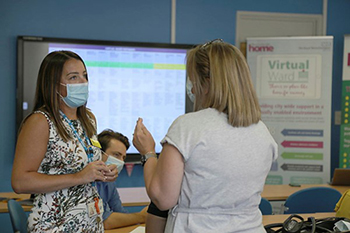Caring for people with acute respiratory infections at home, through a virtual ward in Wolverhampton
Summary
Our ARI virtual ward supports people at home, instead of being admitted into hospital. The virtual ward originally started as an oximetry at home monitoring service. This quickly developed into a COVID virtual ward, supporting people who were still very unwell but could continue their treatment and recovery at home. We are now evolving into an integrated respiratory service, which supports patients at home with COVID, COPD, asthma, oxygen weaning, and acute respiratory infections, such as pneumonia.
Why did you set up the virtual ward?
We tested the concept during the COVID pandemic, and using this learning, we were able to get the virtual ward set up quickly, which improved the confidence of our staff. Our organisation is supportive of innovative ideas like this, as they continue to transform our community models of care.
In 2020, 5,000 patients came to our emergency department (A&E) with acute respiratory infections. Of those, around 1,200 would be admitted – the rest didn’t need to be in hospital but still required some support. Our virtual ward has helped us respond to these challenges.
How did you develop the COVID virtual ward into an ARI virtual ward?
It was an evolutionary process. We didn’t jump straight from one to another. We began to support people with COPD and asthma, and those requiring oxygen weaning. This built up our confidence before we set up the ARI virtual ward. As we already had the digital parts set up for the COVID virtual ward, the ARI virtual ward was relatively easy to establish – it was like a jigsaw putting the pieces together. That took us 2-3 weeks, so it was quite quick.
As with any new care ‘pathway’, we updated aspects of our governance such as our admission criteria, clinical management plan, and developed the skills of our team. We also worked on raising our profile within the hospital, for example, by holding an awareness week, which encouraged colleagues working in other specialties to find out about us and how they could refer patients to the virtual ward. This last element was crucial to our success.
What does your team look like?
The team is made up of nursing and administrative staff and overseen by consultants. We are supported by other members of our hospital’s multi-disciplinary team, including pharmacists and therapists.
How did you engage with other members of staff?
We have an ‘in-reach’ service in the hospital. They talk to other teams in the hospital about our pathways, how we work and how we can help. We make sure staff know what is expected of them and understand our patient criteria.
What have patients said?
“Sally [not real name] is only 18 and had a severe asthma attack which saw her admitted to ICU. We have been so happy with the help [the virtual ward team] provided to ensure an early discharge for Sally. We were desperate for her to get home for recovery where we could see her and care for her and you made that happen!” – a carer
“I would like to say a very big thank you for all your care, support and advice and monitoring me over the last few weeks. I felt safe at home knowing I had the support, it was very much appreciated.” – a patient
“The app was great and within minutes a staff member called me when my heart rate was high, giving advice and reassurances. Staff always … gave me peace of mind. Feeling safe and cared for at home – a great idea.” – a patient
What’s next?
We’re looking to provide as much out-of-hospital care as we can through the virtual ward, particularly when people don’t need to use hospital services.
We are exploring how patients can join the virtual ward when they have been diagnosed in the community. We’re developing our integrated hospital and community respiratory model and recruiting a lead nurse who will link both services and provide more joined-up care for people. We’re also looking to expand the clinical team, for example, adding clinical pharmacists.
Author: Jodie Winfield, Deputy Head of Nursing and Lead for Community Urgent Care, Primary Care and Virtual Ward, The Royal Wolverhampton NHS Trust
